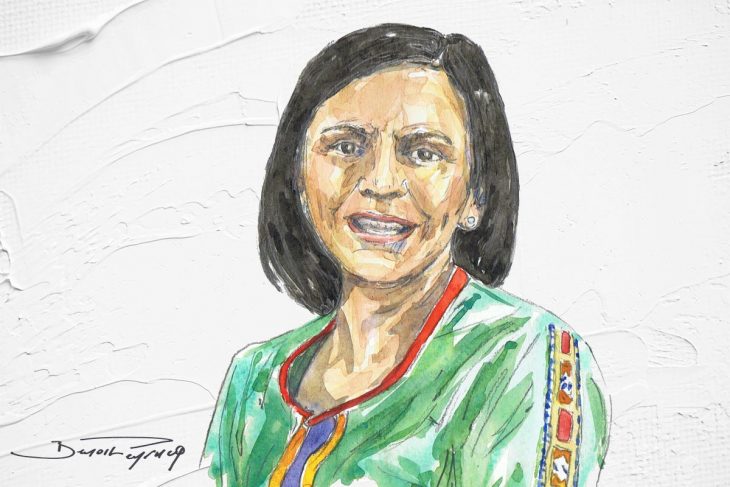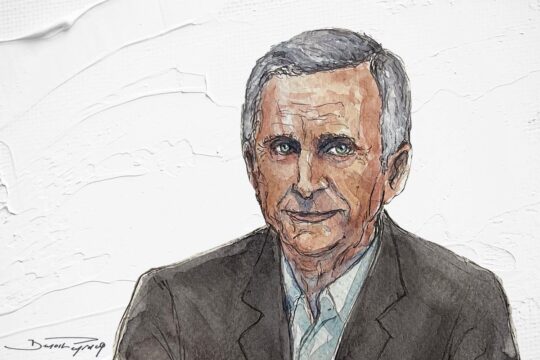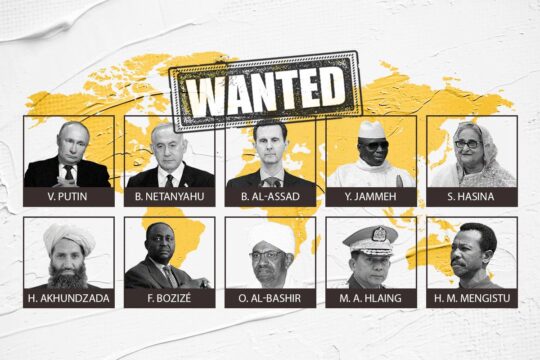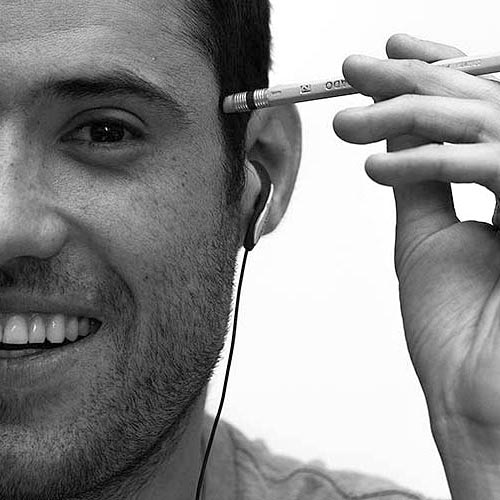JUSTICEINFO.NET IN-DEPTH INTERVIEWS
Patricia Tobón Yagarí
Commissioner in Colombia’s Truth and Reconciliation Commission
Patricia Tobón Yagarí is one of the 11 commissioners serving on Colombia’s Truth and Reconciliation Commission (TRC), one of three transitional justice institutions created as a result of the 2016 peace agreement between the Colombian government and the FARC guerrilla. A member of the Embera Chamí indigenous group and a constitutional lawyer, Tobón has led the TRC’s work with ethnic minorities.
JUSTICEINFO.NET: You are part of the Embera Chamí, one of the many indigenous peoples heavily afflicted by violence during Colombia’s 52-year-long armed conflict. Were you personally affected by war?
PATRICIA TOBÓN YAGARÍ: Yes, my reservation was, and so was I. Guerrillas often came looking for support for their cause. Despite our authorities’ opposition, we saw several leave and later return with their stories of that cruel war. My community’s position of not participating left a mark on me, as well as its clear awareness that that war did not represent us, nor left-wing movements, the guerrillas or the state. That all of them were deeply indebted to us indigenous people.
From a very young age, I understood snippets of that conflict. When I used to go up to the town Andes, rumours flew that the guerrillas were going to besiege it. I saw indigenous communities displaced from Chocó. We suffered kidnappings and cattle rustling. I was especially influenced by the indigenous movement, because the Indigenous Organisation of Antioquia (OIA) was born in my reservation: land recovery mobilisation and women's meetings with my mother, but also threats, imprisonments and the murders of Embera and Sinú indigenous authorities. I remember going with my parents to pay our respects to these communities and to demand armed groups that they stopped assassinating leaders. I have in my mind people who had been in my house and were then killed. When I was older, I witnessed fighting and bombings, I saw people die, I helped pick up the deceased....
When I joined the Commission, I had already heard many stories of victims, of war and even of former combatants. For me the toughest thing has not been listening to these testimonies, but being able to reach agreements on how we understand the conflict.
When I was growing up, many leaders would come up to me and ask me, 'You’re going to study, right?' And I’d reply, 'Yes, of course, I'm going to'. 'And you want to be a lawyer, right?' And I’d say, 'Yes, I’d like to'."
Luis Aníbal Tascón, Colombia's first indigenous lawyer, hailed from your reservation and was murdered -while defending his community’s rights- in 1980. Did he inspire you?
I have always been inspired by his story. Colombia had been a republic for almost two centuries and I’d ask myself, how could he be the first indigenous person with a law degree?
Since I was very young, it was evident to me that indigenous peoples were marginalised and that the national state’s policies towards them were very deficient. I quickly understood that having a lawyer was crucial. I’d always hear in meetings that one was needed to solve any issue - and also that they were there for a while but left when their contracts ended. I knew that my community suffered because it didn’t have a lawyer.
When I was growing up, many leaders would come up to me and ask me, “You’re going to study, right?” And I’d reply, “Yes, of course, I'm going to”. “And you want to be a lawyer, right?” And I’d say, “Yes, I’d like to”.
I studied law out of necessity, because I would have liked filmmaking or anthropology. From my first semester at the University of Antioquia [in Medellin] I supported indigenous councils in demanding their rights: first in Chocó and Valle del Cauca, then in the Orinoquia and La Guajira and, after graduating, outside the country, in the Peruvian Amazon. I also participated in a school for territorial conflict resolution with black and peasant communities in the Pacific, which brought me closer to inter-ethnic processes.
Officially, there are 9 million victims of the armed conflict. Almost 18% of them belong to ethnic minorities: 1.1 million are Afro-Colombian, 515,000 indigenous and 10,000 Roma or Gypsies, when - according to the 2018 census - they amount to 10% of the population. Beyond these numbers, what truths does Colombia need to look in the face?
A crucial one is that the armed conflict we have endured is also the expression of a long-standing ethnic and identity-based conflict, a result of colonial relations that the country has not overcome throughout the construction of the republic. It is difficult for Colombia to accept this root of the conflict, given that it has constructed the theory of its birth based on the Cold War and has understood it as an armed and ideological one.
This is a difficult truth, but a necessary one in order to think about the transition towards peace in comprehensive terms. Indigenous and Afro-descendant victims have suffered multiple acts of victimization, but it is very difficult to redress them because many cannot read or write, because they were excluded for years from public services and educational projects. Getting them out of this poverty gap does not take a compensation on a family-by-family basis, but rather historical reparations that undo this colonial treatment, mitigate social inequalities and dignify them.
One challenge for the TRC is to explain the relationship between these socio-historical factors and the conflict. Its work delving into history by listening to a myriad of voices paves the way for this.
We need to gain awareness of the 115 indigenous peoples in the country, of their history, their conflicts, their needs and their contributions."
Are Colombians aware of the extent to which ethnic peoples were brutalized?
Deep down, we’re all aware of this reality, but we suffer from a kind of national shame about our ethnic roots, as a consequence of colonialism and this socio-cultural project that we have not overcome. Within this centralist project, of big cities and an education striving to be white, Colombians do not learn about their ethnic peoples or territories. The result is that we have been educated with a distortion of reality.
It will require institutional efforts and educational policies -from early childhood to university- for the country to become aware of its intercultural nature. We need to gain awareness of the 115 indigenous peoples in the country, of their history, their conflicts, their needs and their contributions. It is very difficult to change this if the perspective of knowledge doesn’t change. You cannot relate to something you do not know. The TRC allows us to open up this reflection.
How does this ethnic approach function in the TRC’s work?
We have managed to lead a tough conversation. I can say today that in the Truth Commission, civil servants have been educated on what an ethnic approach means.
When we began working, I felt that Ángela Salazar [the Afro-Colombian commissioner who died in 2020] and I were seen as the diversity of the nation, but nobody really understood what that meant. The first thing we did was gather the ideas that indigenous, black and gypsy peoples had pushed for in recent years on truth-building and the origins of the conflict, as well as reports from the Ombudsperson’s Office, the Comptroller General and the Inspector General on Colombian state institutions’ ethnic shortcomings and the recommendations of the UN special rapporteurs for indigenous and Afro-descendant peoples.
From this, we devised an 'ethnic methodology against racism, racial discrimination and other related forms of intolerance'. Why did we call it this? Because our wager was to create an institution that acknowledges that the first thing it must do is reflect on racism within and include ethnic staff. By integrating them, we avoided a repeat of what ethnic communities and victims have long complained about: that public servants would arrive in indigenous territories and take up to three years to understand those who live there.
The three institutions of Colombia’s transitional justice system carried out consultations with ethnic minorities, something innovative on a global level. Why was this important?
It was a tough process, but in the end this intercultural dialogue transformed the TRC. Some initially opposed it, not out of ill will but because they didn’t understand what it was needed for. I especially remember two arguments put forward by indigenous leaders.
They told [TRC chairman] Father Francisco de Roux: “You can’t study the history of the Muslims with the Catholic Bible because it doesn’t cut it. And you can’t study the history of the indigenous people with a Western mindset because it doesn’t cut it. This is why we need an ethnic chapter with guarantees that we can incorporate our truth freely, so that it becomes part of the national narrative and is not subordinated to a majority culture.”
They also told Alfredo Molano [a sociologist, writer and TRC commissioner, who died in 2019]: “When we indigenous peoples ask friends for help, we’re not always asking them to give us a hand, but sometimes for them to take it away. What we now need is to explain the way we understand the conflict from our experience.” What they meant was that they do not see the conflict as beginning in 1957, but spanning the Conquest, the Colony and the Republic.
I also remember that Afro-descendants argued that one origin of the conflict is racism. If we look at the way history is told in the Museum of the Caribbean, they said, we see that the people of Barranquilla descended from Italians, Spaniards and Lebanese, but if we look at the Caribbean population, we see that the majority is African. These white descendants kept control of power, narrative and representation of the Caribbean. These debates were very important.
FARC caused ethnic peoples a lot of pain. Paramilitaries and the state did so too. There is not a single reservation that has not been affected."
The Colombian TRC is opting for a mixed model, with a final report and hearings, despite the Covid-19 pandemic. Why is an ethnic chapter important?
The fact that there is going to be a chapter [in the final report] on the situation of ethnic peoples is fundamental. On the one hand, the narrative of indigenous, Afro-descendant and gypsy peoples about how the armed conflict arrived in their territories is a historical debt.
On the other hand, FARC caused ethnic peoples a lot of pain. Paramilitaries and the state did so too. There is not a single reservation that has not been affected. Ethnic peoples’ truth will not justify these actors’ actions, but focus on the trauma they suffered. For those who see reality in only one colour, this will be tough because they’re here to talk about grey areas.
Finally, I personally hope that the report will contain recommendations on the armed conflict and also on historical reparations, both of which can help to stop the continuum of violence in which we still find ourselves.
I believe that its added value is that it will have an impact on the way in which new generations of Colombians understand their origins and the challenges they face in terms of their history. If we dignify those roots, we can change the way we treat these populations.
One powerful hearing was when the former paramilitary boss Salvatore Mancuso admitted having murdered the Embera leader Kimi Pernía in 2001 and apologized to his daughter Martha Domicó. How important was this for indigenous people?
For indigenous peoples, there is redress in seeing that what they have denounced for years is now acknowledged and explained by those responsible for the armed confrontation. It’s not the same to see a victim to say it as it is for Mancuso to do it: to see him narrate, for example, how food transport was restricted as a strategy to stigmatize communities, or how in the counter-insurgency struggle the paramilitaries ended up doing the dirty work for the military.
This willingness of indigenous peoples to listen to Mancuso’s background story, not just the specific events concerning them but also his life story and why he entered the war, allows us all to understand factors of persistence and to unveil issues that we need to look at in depth in a country where cycles of violence continue to happen.
This dialogue between perpetrators and victims has helped the Commission open similar conversations at a national level and has allowed a greater knowledge of many events that Colombian society was not aware of.
How did you arrive at these dialogues between ethnic victims and perpetrators?
It was a methodology born during the process of ethnic consultation. Indigenous authorities decided that they would select some cases and send letters to the perpetrators so that, later on, victims could testify before the TRC in front of them. This paved the way for a much more profound and sincere dialogue between victims and perpetrators. Some conversations were private, others public - but always had both sides talking, with the terms being what victims experienced in their territories.
This year we will hold 16 more dialogues, with former FARC rebels and paramilitaries, with ethnic and peasant victims. In the end, this methodology is another example of the contributions made by indigenous and black peoples in promoting processes of healing, coexistence and truth-seeking.
Indigenous communities have historically had to deal with everyone passing through their territories because, faced with the reality of having to confront people who are armed, one has no protection other than words."
You have spoken of the Embera philosophy of 'thinking big', which consists not of doing so with family or friends, but with those who think differently. Has the TRC achieved this?
What we have done contributes, but we are still a bit far from sitting down with those who are different in Colombia. Indigenous communities have historically had to deal with everyone passing through their territories because, faced with the reality of having to confront people who are armed, one has no protection other than words. In the midst of this, communities have developed strategies for dialogue and mediation, which we hope will serve to promote more conversations between different people in our country.
In parallel to the TRC’s work, the Special Jurisdiction for Peace (JEP) is making progress in building judicial cases of violence against indigenous groups. There is a macro-case centered on the extermination of the Awá in Nariño and another on the recruitment of child soldiers –many of which were indigenous– by the FARC. How have you worked with the JEP?
As a comprehensive transitional justice system, we have to work together. Victims have asked us to do so, insisting that we not make them repeat their truth in multiple institutions, but that we gather what they have already told either of us and work in a coordinated way.
This is the reason why we carried out an ethnic consultation process as a system, including the JEP, the TRC and the Unit for the Search for Disappeared Persons. We have gone to their territories together to listen to victims, to receive their reports - both oral and written - and to learn about the realities of the communities. We have also received from the JEP the information and the testimonies it has gathered, all of which have been fundamental input in the analyses we are carrying out.
How can the TRC ensure that its work has an impact for indigenous peoples?
Including the narratives about the conflict of indigenous, Afro-descendant and Gypsy peoples in this narrative of the nation is undoubtedly a milestone, because until now research on it has been carried out mainly by people who were not born into ethnic groups.
This analysis also includes other issues they want to continue discussing with the rest of Colombians, such as the relationship between the nation-state and indigenous peoples, the relationship between racism and the armed conflict, or the web of economic interests that converge in ethnic territories and that the rest of the country often doesn’t see.
Now, more than simply having an impact on indigenous peoples, the TRC’s report also seeks to make a mark on Colombian society with regard to ethnic issues, because there is a great deal of work to be done there. I believe that it could be one of the first documents that allows us to generate this conversation with Colombian society. It is a document for the whole nation and, for the first time in the republic, one that tries to break with the colonial narrative with which our national society has been educated.
I believe that this reflection will allow indigenous peoples to advance a much broader agenda of discussion with the whole of Colombian society and the Colombian state."
Many of these debates take time to digest and correct. Is this a long-term agenda?
Yes, it is. I believe that this reflection will allow indigenous peoples to advance a much broader agenda of discussion with the whole of Colombian society and the Colombian state.
In November, the TRC’s three-year mandate will come to an end. What would you like its legacy to be?
I think that, when we look at this process with historical perspective, one of its legacies will be the active participation of ethnic peoples - in the construction of the report, in the selection of cases, in its work methodologies, in the process of corroborating information.
The Colombian Truth Commission was the first one in the world to carry out a consultation process with ethnic peoples. It constructed a differentiated methodology, based on recognizing historical deficits and debts, but also the demands for institutional adaptation that ethnic peoples have underscored in relation to the state and the transition towards peace itself. The TRC has made an enormous effort to - truly - incorporate them.
Time will tell us what can happen, but I believe that the work we have done is inspiring. Many indigenous organizations have told us that they want to continue documenting their history, no longer with the Commission but out of their own free will, to show it to the rest of Colombia. I have also seen a huge transformation in my colleagues’ relation to our ethnic reality. This is all part of rediscovering who we are.
Interviewed by Andrés Bermúdez Liévano, our correspondent in Colombia
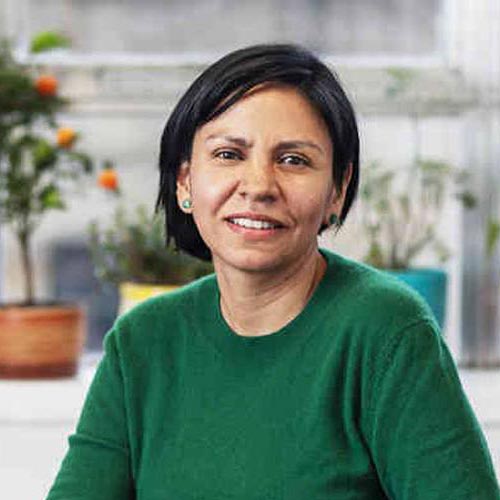
Patricia Tobón Yagarí has been a member of Colombia’s Truth and Reconciliation Commission since its creation in late 2018. For five years she was a lawyer at the National Indigenous Organization of Colombia (ONIC), the country’s largest indigenous organisation, where her work focused on defending indigenous rights, documenting human rights abuses and representing indigenous peoples before instances like the Inter-American Human Rights Commission. Her selection as TRC commissioner made her –along with four indigenous colleagues currently serving as justices on the Special Jurisdiction for Peace – probably the highest-ranking indigenous public servants in Colombian history.


